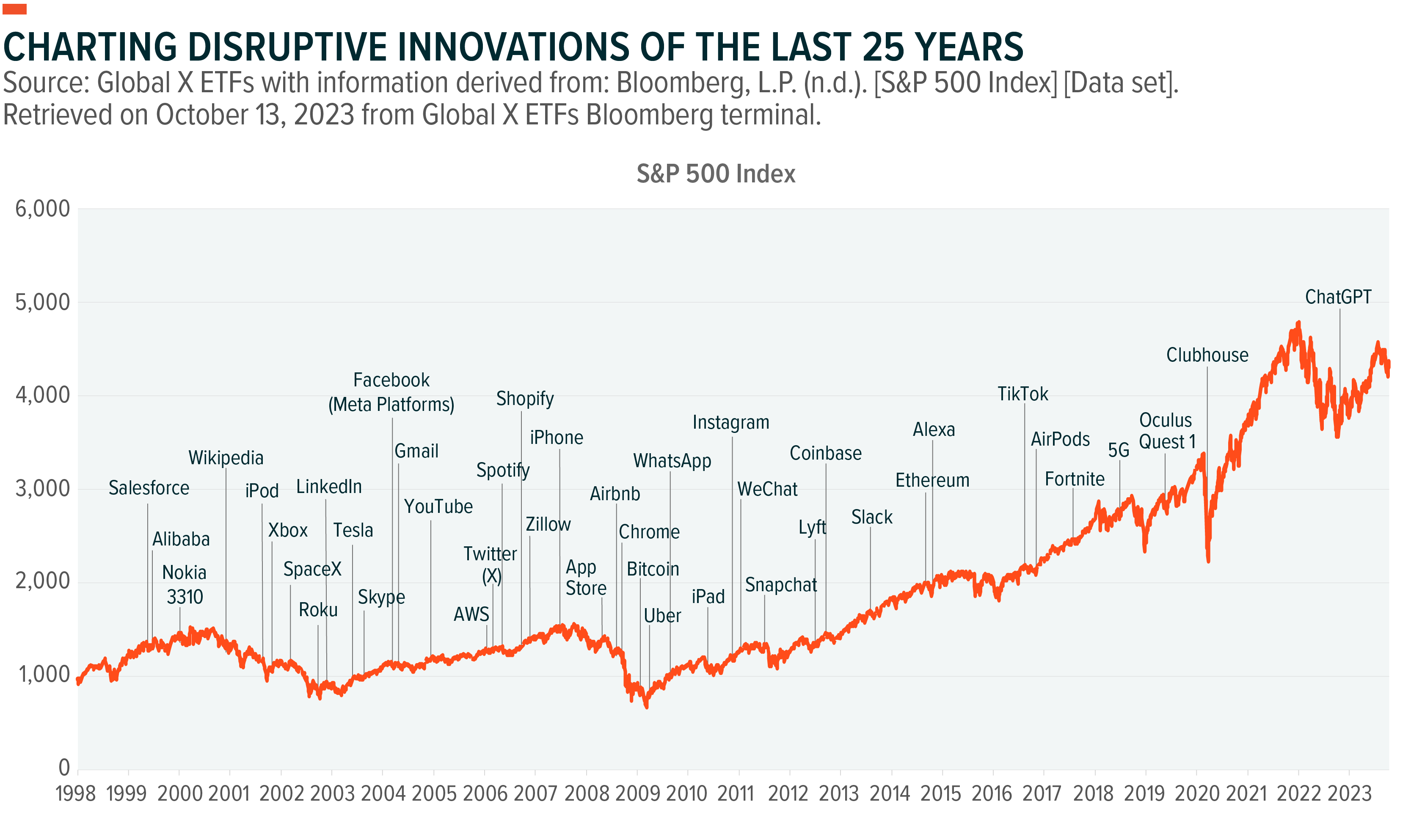Human imagination and innovation continuously drive technological advances, but the scope and scale of the potential disruption seem unimaginable – until we start implementing the changes and adapting our daily lives. Our flagship research project, Charting Disruption, aims to shed a quantifiable light on what the future may hold. We explore the interplay between innovation and emerging technological as well as behavioral trends that can shape financial markets and their performance.
In charting potential disruption, looking back at the groundbreaking work of yesterday provides an essential perspective to understanding key current and future technological trajectories. It can be easy to underestimate the capacity for global change within a lifetime, but recognizing past dramatic shifts can help us envision a vastly different world in the years and decades ahead.

Key Takeaways
- Charting disruption allows us to look back at the inventions of yesterday to forecast the changes we anticipate tomorrow.
- In Charting Disruption, we present unique forecasts, datasets, and analyses that reveal what we expect to disrupt our world in 2024 and beyond.
- We predict a future marked by groundbreaking technologies, greener solutions to global issues, pioneering medical advances, as well as remarkable growth and innovation in digital assets.
The Unimaginable Today Will Be Familiar Tomorrow
In the United States, recent landmark legislation laid the groundwork for a strong foundation that now paves the way for the modernization, innovation, and creation necessary to bring yesterday’s infrastructure into the future. Along with building literal bridges, the evolution already seen in the development and application of artificial intelligence (AI) is building a figurative bridge to revolutionary models with the potential to impact every facet of life as we know it.
The influence of generative AI in robotics is undeniable and with numerous, clear benefits for industrial use, robotics in this space have already hit unprecedented benchmarks, while sitting poised for further growth particularly in the service and delivery sectors. The latter is top of mind, as global movement continues to be a priority and several breakthroughs in battery technologies, as well as the infrastructure and support needed for wider implementation, prove greener solutions are not only achievable, but ripe for adoption.
A common thread of topical concern, for both companies and individuals, lies with the dangers of climate change and the solutions required to mitigate and undo its adverse effects – an arena primed for progress as interest and data for evidence-based solutions increase exponentially. All of these disruptions benefit from the cloud computing underlying the technology these innovative companies use to optimize their communications, data collection and storage, as well as cybersecurity – all realms with additional opportunities for growth.
Another area on the cusp of modernization, many of the inefficiencies in the healthcare system, as well as patient monitoring, can benefit from such technological solutions as those involving artificial intelligence and wearable sensors. Such advances aid not just the administrative and operational elements of the healthcare system, but recent progress in genomic technologies allows for increasingly effective disease management and illness prevention. While the technological advances in understanding and manipulating the human genome have already provided the foundation for significant advances in healthcare, current research demonstrates the further potential for growth.
Digital technology really leaves no arena of daily life untouched, a trend evident in consumer habits, as ecommerce remains popular and disruptive financial services continue to grow. Cryptocurrencies signal a massive disruption in the financial sphere. Time and innovation help to further establish these, driving adoption in countries with a history in technological development, as well as politically and economically troubled countries that see the opportunities in alternative currencies. The underlying technology of digital transactions also continues to develop. The potential use cases appear vast, with almost unlimited applications – and the exploration of these creative possibilities is already well underway.
In short, the digital world continues to grow and adapt to the needs and desires of people on micro and macro levels, so it comes as no surprise that this translates into who, what, where, where, when, why, and how people obtain information and manage their social experiences. The advances in just the last 25 years alone prove momentous, particularly in the depth of global connectivity spurred by the internet and smartphones. Even now, digitally native generations outnumber digitally immigrant generations.
Humans relentlessly work to shape, create, and revolutionize our global ecosystem. We predict a future marked by paradigm-shifting technologies, the evolution of sustainable solutions, cutting-edge medical advances, as well as the expansion of digital assets and the possibilities they present.
 Pedro Palandrani
Pedro Palandrani